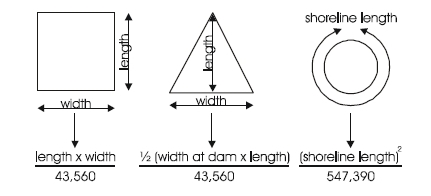Many landowners enjoy fishing, swimming, providing wildlife habitat, and relaxing beside recreational ponds on their property. Many more are considering to build a pond right now. Because pond construction is an important component of sucessful, long term pond management, here are some important aspects every future pond owner should consider.
Pond Site – Site selection is extremely important when it comes to building a pond. I suggest contacting your local Natural Resources Conservation Service (NRCS) office and they can assist in site selection, soil suitability, engineering survey, and design. They can estimate the cost of the earthwork, make quality control checks during construction, and provide information on other aspects of planning, design, and pond construction.
Before you design your pond, consider the shape of the land, water supply, and soil type. If possible, consider more than one location, and study each one to select the most practical, attractive, and economical site.
Pond Soil – Suitable soil is one of the primary factors in selecting a pond site. The soil should contain a layer of material that water will not seep through. Clays and silty clays are excellent soils for holding water. Sandy clays can work, but avoid soils that are well drained. To determine suitability, take soil samples at frequent intervals and have them analyzed. Again, the NRCS office can assist with this evaluation. Not evaluating soil strata properly could result in a pond that will not hold water, and that will make proper pond management very difficult. After all, you need water to have a pond!
An NRCS or county extension agent can advise you how to collect soil
samples for analysis to determine the soil pH and lime requirements (of the pond bottom) for the site you have selected. Most state soil testing labs charge only a small fee for soil samples, and they are well worth the costs.
Topography – Consider topography first when it comes to pond construction because it directly affects building costs and pond management. Put the pond where enough water can be impounded with the least amount of earth fill. A good site is usually one where you can build a dam across a narrow section of a valley and where the slope of the valley floor lets you flood a large area. Such sites are ideal and minimize areas of shallow water.
Avoid large areas of shallow water because they become too shallow to use in late summer and fall dry periods, and they encourage undesirable aquatic plants (weeds). However, if you are interested in providing additional habitat for waterfowl, then these shallow areas should be considered an asset to your pond. However, additional management practices will be necessary to maintain this habitat on an annual basis.
Pond Water Supply – Water should be adequate, but not excessive, and may be provided by springs, wells, or surface runoff. For ponds where surface runoff is the main source of water, the contributing drainage area should be large enough to maintain a suitable water level during dry periods. This is critical.
However, the drainage area should not be so large that expensive
overflow structures are needed and water exchange occurs too
frequently. As a rule of thumb, a pond should have 5 to 10 acres of
drainage area for each acre of impounded water. The amount of
runoff to be expected from a watershed depends on topography,
soil type, and plant cover. Make sure to keep the watershed planted in healthy grass cover to prevent muddy water after each rain. Good grass cover
Keep in mind that deeper ponds do not necessarily produce more fish than shallow ponds. In fact, shallow ponds tend to be more productive, but ponds that are too shallow suffer the risk of drying under summer drought. The average pond depth should be about 4 feet. This lets fish forage on the bottom, even in summer, when low oxygen concentrations are common in deeper water, while maintaining enough depth to sustain the fish during drought.
Pond Management – Proper pond construction will go a long ways towards allowing pond owners get maximum enjoyment from their pond while minimizing maintenance. Before building your pond, use the above information to do it right from the start and your pond will provide recreational opportunities for a lifetime.

